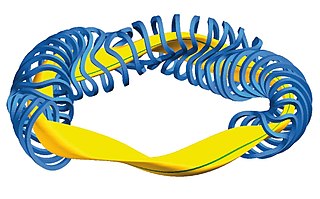
A stellarator is a device that confines plasma using external magnets. Scientists aim to use stellarators to achieve controlled nuclear fusion. It is one of many types of magnetic confinement fusion devices, the most common being the tokamak. The name "stellarator" refers to stars as fusion also occurs in stars such as the Sun. It is one of the earliest fusion power devices, along with the z-pinch and magnetic mirror.
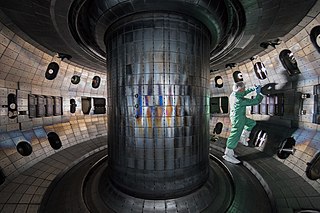
A tokamak is a device which uses a powerful magnetic field generated by external magnets to confine plasma in the shape of an axially symmetrical torus. The tokamak is one of several types of magnetic confinement devices being developed to produce controlled thermonuclear fusion power. The tokamak concept is currently one of the leading candidates for a practical fusion reactor.

A fusor is a device that uses an electric field to heat ions to a temperature at which they undergo nuclear fusion. The machine induces a potential difference between two metal cages, inside a vacuum. Positive ions fall down this voltage drop, building up speed. If they collide in the center, they can fuse. This is one kind of an inertial electrostatic confinement device – a branch of fusion research.

Fusion power is a proposed form of power generation that would generate electricity by using heat from nuclear fusion reactions. In a fusion process, two lighter atomic nuclei combine to form a heavier nucleus, while releasing energy. Devices designed to harness this energy are known as fusion reactors. Research into fusion reactors began in the 1940s, but as of 2024, no device has reached net power, although net positive reactions have been achieved.

Inertial electrostatic confinement, or IEC, is a class of fusion power devices that use electric fields to confine the plasma rather than the more common approach using magnetic fields found in magnetic confinement fusion (MCF) designs. Most IEC devices directly accelerate their fuel to fusion conditions, thereby avoiding energy losses seen during the longer heating stages of MCF devices. In theory, this makes them more suitable for using alternative aneutronic fusion fuels, which offer a number of major practical benefits and makes IEC devices one of the more widely studied approaches to fusion.

Aneutronic fusion is any form of fusion power in which very little of the energy released is carried by neutrons. While the lowest-threshold nuclear fusion reactions release up to 80% of their energy in the form of neutrons, aneutronic reactions release energy in the form of charged particles, typically protons or alpha particles. Successful aneutronic fusion would greatly reduce problems associated with neutron radiation such as damaging ionizing radiation, neutron activation, reactor maintenance, and requirements for biological shielding, remote handling and safety.
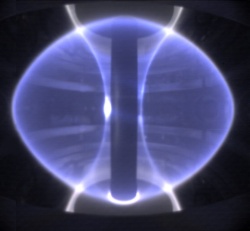
Magnetic confinement fusion (MCF) is an approach to generate thermonuclear fusion power that uses magnetic fields to confine fusion fuel in the form of a plasma. Magnetic confinement is one of two major branches of controlled fusion research, along with inertial confinement fusion.
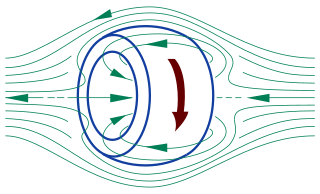
A field-reversed configuration (FRC) is a type of plasma device studied as a means of producing nuclear fusion. It confines a plasma on closed magnetic field lines without a central penetration. In an FRC, the plasma has the form of a self-stable torus, similar to a smoke ring.
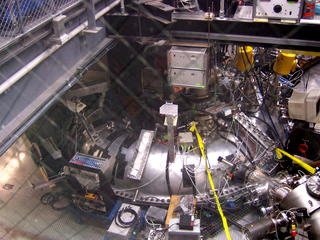
The Madison Symmetric Torus (MST) is a reversed field pinch (RFP) physics experiment with applications to both fusion energy research and astrophysical plasmas.
A dusty plasma is a plasma containing micrometer (10−6) to nanometer (10−9) sized particles suspended in it. Dust particles are charged and the plasma and particles behave as a plasma. Dust particles may form larger particles resulting in "grain plasmas". Due to the additional complexity of studying plasmas with charged dust particles, dusty plasmas are also known as complex plasmas.
The beta of a plasma, symbolized by β, is the ratio of the plasma pressure (p = nkBT) to the magnetic pressure (pmag = B2/2μ0). The term is commonly used in studies of the Sun and Earth's magnetic field, and in the field of fusion power designs.
The polywell is a proposed design for a fusion reactor using an electric and magnetic field to heat ions to fusion conditions.
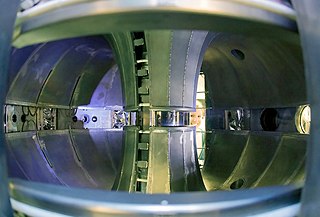
The Lithium Tokamak Experiment (LTX), and its predecessor, the Current Drive Experiment-Upgrade (CDX-U), are devices dedicated to the study of liquid lithium as a plasma-facing component (PFC) at Princeton Plasma Physics Laboratory.
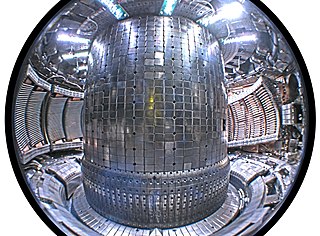
In nuclear fusion power research, the plasma-facing material (PFM) is any material used to construct the plasma-facing components (PFC), those components exposed to the plasma within which nuclear fusion occurs, and particularly the material used for the lining the first wall or divertor region of the reactor vessel.

In magnetic confinement fusion, a divertor is a magnetic field configuration which diverts the heat and particles escaped from the magnetically confined plasma to dedicated plasma-facing components, thus spatially separating the region plasma-surface interactions from the confined core. This requires establishing a separatrix-bounded magnetic configuration, typically achieved by creating poloidal field nulls (X-points) using external coils.
TAE Technologies, formerly Tri Alpha Energy, is an American company based in Foothill Ranch, California developing aneutronic fusion power. The company's design relies on an advanced beam-driven field-reversed configuration (FRC), which combines features from accelerator physics and other fusion concepts in a unique fashion, and is optimized for hydrogen-boron fuel, also known as proton-boron or p-11B. It regularly publishes theoretical and experimental results in academic journals with hundreds of publications and posters at scientific conferences and in a research library hosting these articles on its website. TAE has developed five generations of original fusion platforms with a sixth currently in development. It aims to manufacture a prototype commercial fusion reactor by 2030.

The Hybrid Illinois Device for Research and Applications (HIDRA) is a medium-sized toroidal magnetic fusion device housed in the Nuclear Radiation Laboratory and operated by the Center for Plasma-Material Interactions (CPMI) within the Department of Nuclear, Plasma and Radiological Engineering at the University of Illinois at Urbana–Champaign, United States. HIDRA had its first plasma at the end of April 2016 and started experimental campaigns by December of that year. HIDRA is the former WEGA classical stellarator that was operated at the Max Planck Institute for Plasma Physics in Greifswald Germany from 2001 to 2013.
Colliding beam fusion (CBF), or colliding beam fusion reactor (CBFR), is a class of fusion power concepts that are based on two or more intersecting beams of fusion fuel ions that are independently accelerated to fusion energies using a variety of particle accelerator designs or other means. One of the beams may be replaced by a static target, in which case the approach is termed accelerator based fusion or beam-target fusion, but the physics is the same as colliding beams.
Low to High Confinement Mode Transition, more commonly referred to as L-H transition, is a phenomenon in the fields of plasma physics and magnetic confinement fusion, signifying the transition from less efficient plasma confinement to highly efficient modes. The L-H transition, a milestone in the development of nuclear fusion, enables the confinement of high-temperature plasmas. The transition is dependent on many factors such as density, magnetic field strength, heating method, plasma fueling, and edge plasma control, and is made possible through mechanisms such as edge turbulence, E×B shear, edge electric field, and edge current and plasma flow. Researchers studying this field use tools such as Electron Cyclotron Emission, Thomson Scattering, magnetic diagnostics, and Langmuir probes to gauge the PLH and seek to lower this value. This confinement is a necessary condition for sustaining the fusion reactions, which involve the combination of atomic nuclei, leading to the release of vast amounts of energy.
Boronization is a wall conditioning technique for fusion machines, where a thin film of boron is deposited on the walls of the vacuum vessel in order to reduce the impurity content which can be deleterious for fusion plasma operation.











